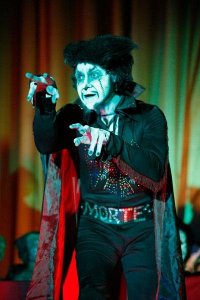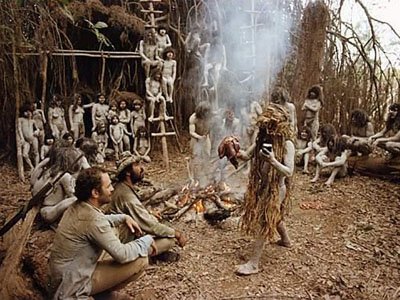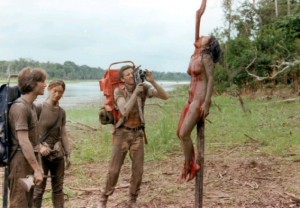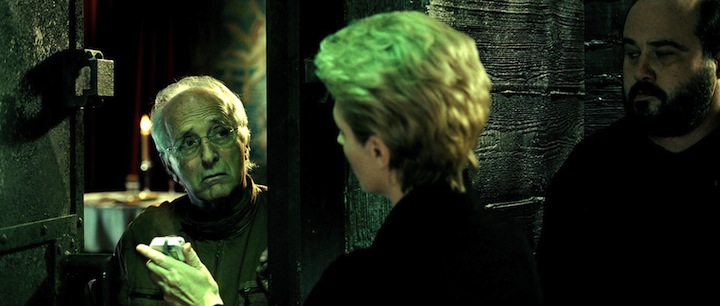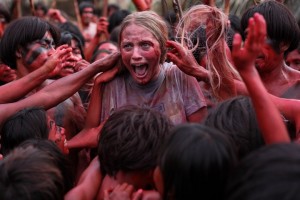By S.J. Chambers
Contributing Writer
From Wed. June 11 through Sun. June 15, Ft. Lauderdale, FL will be getting the Tiki treatment as enthusiasts seeking “a mini-vacation” replete with umbrella-garnished drinks and exotica tunes gather at the Bahia Mar Resort for the 13th annual Hukilau. It sounds just like the type of vintage vacation ATLRetro needs, so we will be on location sending you social media postcards from the event.
Tagged as the world’s most authentic Tiki event and founded by Christie “Tiki Kiliki” White, Hukilau has been keeping this retro culture of Polynesian kitsch and tropical libations alive and well since 2002, where the first festivities were Atlanta-born at Trader Vic’s. The event ventured South in 2003, to honor the Mai Kai Restaurant, one of the last original Tiki establishments left that serves Don the Beachcomber’s original recipes while entertaining dinners with an authentic Luau floor show. Each year has always outdone the last, bringing out performers such as Robert Drasnin and Los Straitjackets, renowned artists like Swag and Bosko, and the foremost Tiki gurus like Sven Kirsten, and Duda Leite. This year looks to be no different as the Hukilau has a full schedule of musical acts like The Intoxicators, performances by Marina the Fire-Eating Mermaid (Medusirena), and seminars by cocktail historians Philip Greene and Jeff “Beachbum” Berry.

Jeff "Beachbum" Berry. Photo by Rimas Zailskas.
With six books and two apps based on his tropical findings, Berry is the foremost mixologist of Tiki Drinks, and has become the most sought-after consultant and critic of the Tiki and retro-bar scene. He was included among “25 Most Influential Cocktail Personalities of the Past Century” by IMBIBE magazine and has been called “one of the instigators of the cocktail revolution” by ESQUIRE. In addition to that, he has been featured and published in BON APPÉTIT, FOOD & WINE, NEW YORK TIMES, WINE ENTHUSIAST, among many other premier publications, and has had his drinks served in the premier bars around the world like Paris’ Le Tiki Lounge, San Francisco’s The Smuggler’s Cove, and the Windy City’s new Three Dots and A Dash.
His latest book, POTIONS OF THE CARIBBEAN, is a riveting coffeetable-style book that traces the Tiki cocktail’s main ingredient, rum, through its inception as a West Indie intoxicant and its evolution to becoming the main ingredient to the 1950s U.S. Tiki craze.
In his introduction, he writes that: “POTIONS is basically an answer to a question I asked myself 30 years ago, sitting in a restaurant I couldn’t afford while sipping a drink I didn’t understand. The restaurant was Trader Vic’s, the drink a Navy Grog. Why did I like this drink as much as I did? Where did it come from? Why couldn’t I figure out what was in it?” It would take sussing out the problem in four books until the a-ha moment occurred: “…it finally began to dawn on me that, almost without exception, the drinks served in my beloved South Pacific-themed restaurants and bars all had their roots in the Caribbean. For more years, than I care to admit, I’d been swimming in the wrong ocean.”
Berry could not find any text that made the Tiki/Caribbean connection, so he set out to create that text, and POTIONS was the result. The Caribbean, of course, is not a light topic, and its bloody history of colonial conquest and Imperialism makes for subject matter darker than the oldest, molasses-infused rum. Under another’s pen, a book about this region could be daunting and obviously depressing, but with rum and cocktail archeology as the book’s focal point, Berry is able to write in a smart and anecdotal manner that makes for fast and enjoyable reading while not shying away from the West Indies brutality. Plus, it is chock full of historical and delicious recipes, including 16 unpublished recipes as well as 19 unpublished in book form.
ATLRetro was fortunate enough to pre-game with the Beachbum and discuss his new book, as well as get the scoop on his TOTAL TIKI app, his Hukilau seminar, and the future of Tiki. We worked up such a thirst, he was kind enough to share with us his honorary recipe he crafted for the annual occasion. Mahalo!
How long have you participated with the Hukilau. This is its 13th year? What do you think its biggest contribution to Tiki culture has been?
I think I’ve been going since 2006. And I haven’t missed one yet.
I think what it has done is served as a kind of a matrix for every aspect of Tiki culture on the Eastern seaboard. It’s provided a focal point for everybody to gather and exchange what we found, because it’s all vintage stuff, but it’s like people that live in New York, or they live in Washington, DC, or they live in Louisiana, or they live in Tennessee, and they find things at thrift stores and swap meets, and there’s really not a whole lot of people in a 100 miles radius, sometimes, of you that are into this stuff. So what the Hukilau does [is lets] you can bring all this new stuff you’ve found there and either share it, or sell it, or make people aware of it, and it’s kind of added to the knowledge bank of what the mid-century Tiki scene was like and what existed then, and it’s also a great way for people to compare notes…even what everyone [is] wearing. It even comes down to that sometimes….
It’s that, it’s the music, the actual history, the archeology, cuisine and drinks. The Hukilau provides this short gathering and exchange for all [of] this stuff. I think what’s specific to Tiki culture [is that] people bring that back with them, and they feel like that there is a Tiki culture and its not just something they’re into and nobody knows what it is; that there is this shared subculture they can all be a part of, and that kind of fosters the culture and stresses it and deepens it.
You will be presenting your sold-out seminar “Tiki’s Dark Ages: From Fern Bars to Rebirth” this Thursday. What can attendees look forward too?
What the seminar is going to be about is mostly the 1980s and the 1990s—those were Tiki’s dark ages. That’s when the whole Tiki craze crashed in the 70s with the dawn of disco and margaritas took over for Mai Tais and everything that we know and love…just kind of crashed and the dark ages ensued when you couldn’t get a decent drink, and it all seemed like it was totally hopeless to ever see that stuff come back again.
I think everybody at the Hukilau probably lived through the Tiki dark ages. It isn’t really a young crowd; everybody was around and drinking in the 80s and 90s, most of them anyway. So, I think it will be more of a personal story of how the whole revival came about, out of the ashes, if you will.
When did the revival begin to surface again?
It surfaced in little pockets around the country. Before the Internet, you had a big resurgence of it in Southern California, because it never totally, really went away. There was beach culture, there was surf culture, hot rod culture, the whole lounge music revival and rat pack stuff, rockabilly, tattoo culture, and all that stuff was just sort of this subcultural stew in L.A. in the 90s, and Tiki was part of it. It was just one aspect of it, and nobody really differentiated between any of these things—it was all just underground retro culture—and then Tiki kind of broke off and came in to its own in the early 2000s.
The internet vulcanized the whole underground subculture thing, and everybody sort of became into one thing more than another thing. So Tiki branched off—and then you were either into hot rods, or into rockabilly, or you were into Tiki. It wasn’t like you were into all of that stuff, which everybody originally was, and then everybody focused on what they loved the best because they had groups and chat rooms, like Tiki Central, where they could geek out on it all.
So, the Internet was a huge factor in the Tiki revival in the late 90s, early aughts, and then the cocktail revival [happened.] So, that whole craft cocktail scene, which really looked down its nose at Tiki in the beginning–nobody wanted to touch Tiki drinks with a 10-foot pole; if you ran a craft cocktail bar, you were doing pre-prohibition and 19th century classics–but eventually they started to see the worth of the drinks, and they embraced it, and that really helped lift Tiki up. Because once Tiki drinks became popular, Tiki bars started opening again and more mainstream articles were written about it, and now we are where we are.
That is interesting that the craft cocktail revival didn’t embrace Tiki at first, and that touches on something I’ve always been puzzled about, and that there seems to be two different craft cocktail schools of thought. There’s the people who worship Hemingway, Fitzgerald, the roaring twenties—and now that seems to be coming through MAD MEN—then there’s the Tiki component—the tropical, Polynesian vibe—and I’ve always been puzzled how the two were related or not related to each other. In your book, when you immediately make the point that actually all these tropical drinks come from the Caribbean and not the South Pacific as they are themed, and when you get into Hemingway and Cuba and the art of the daiquiri, it begins to make sense the two worlds should co-habit, but it seems like the people who are interested in one cocktail culture over the other have different vibes they are going for. I can’t see the Don Draper wanna-bes hanging out with the Trader Dons….
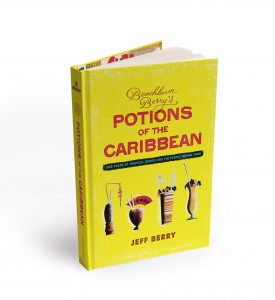
POTIONS OF THE CARIBBEAN (Cocktail Kingdom) is the sixth book in Jeff Berry's Beachbum Berry series.
That’s a really good point and it’s something that’s getting shaken out right now. I was just in Chicago in February…I checked out a lot of the new super high-end craft cocktail bars that were not Tiki, and they all had Tiki drinks on them! Like, there’s one drink called the Jungle Bird, which you can get at every craft cocktail bar now—craft cocktail bartenders love it because there is Campari in it, that’s their gateway to Tiki drinks—but you can go to a non-Tiki craft cocktail bar in Berlin, London, Dubai, Tokyo, New York, San Francisco, and you will find tiki drinks on the menu now. Almost all of them do the original Trader Vic Mai Tai, the Jungle Bird, most of them will do a Zombie. They’re all starting to embrace it…. I think once all those prejudices—that you have to be pre-prohibition, or you’re Tiki, or that you are this or that—is all starting to meld into one general cocktail vibe. And Tiki drinks are taking their place in the canon alongside all the Jerry Thomas stuff, and the Fitzgerald stuff, and all that.
MAD MEN was actually kind of a synthesizer for Tiki. I forget what season it was, but there’s one season where Don Draper and one of his potential mistresses are hanging out in a hotel bar drinking Tiki drinks, and then the next season they ended up in Hawaii and at the Royal Hawaiian. [See “The Doorway,” episode 1 of season 6]. Tiki was a huge part of the MAD MEN era and a huge part of the sixties, and they paid attention to that in several of the episodes. I haven’t binged out on the last season or two, but they were definitely moving in that direction before I stopped keeping track of it.
A sense of travel was integral to the whole “backyard Polynesian” lifestyle back in Don Draper’s time, which stemmed from so many having served in the South Seas, and the nostalgia they would feel for the Pacific when back in civilian life. If they experienced an aspect of the Polynesian lifestyle first hand, why did they not care that the drinks they were drinking were not from the place they were “traveling” too?
You just hit on the entire theme of Sven Kirsten’s books, and the $64,000 question about this whole thing. Nothing about Tiki is authentic; it’s all faux. It’s all this made up mid-century American faux-naive take on primitive culture. Anything exotic, anything that was the other—if you look at record albums from the 50s—exotica music—you saw voodoo mixed up with Hawaii mixed up with African drums mixed up with Samba. It didn’t matter to these people as long as it was exotic and not red-blooded, bland, Eisenhower America. They just sort of lumped it all together in this umbrella term of exotica…and you go to Tiki places where there’d be African masks that had nothing to do with Oceania and it didn’t really concern anybody in the American middle-class suburban culture of the 50s and 60s that this stuff wasn’t authentic.… People took lots and lots of liberties, and Sven touches on this in his last book.
So is that the modern appeal of Tiki—the pure fantasy? That it’s a packaged idea you can play within?
This cocktail guy named Robert Hess summed it up when someone asked him what he thought Tiki meant, and he thought it was a mini-vacation. And I think that’s why the trend is going mainstream. It’s not so much a sub-culture theme anymore, it’s big money now.
There’s a place in Chicago called Three Dots and a Dash serving 2000 drinks a night, and it’s a Tiki bar, and it’s expensive and it has a velvet rope where people wait to get in. That’s what’s happening to Tiki right now, and certainly that’s what’s been happening for years in places like London, like at Mahiki, where Madonna and the Royal Family go drop thousand of pounds a night. So what you’re finding is it’s this mini-vacation and I think people are into that. The worst it can get with the economy and the political situation, with global warming, with all the things that can kill you or ruin your life, that’s all good for Tiki. People flock to Tiki bars and the worse it can get the better Tiki bars are. It’s a mini-vacation, an escape.
Let’s talk about the TOTAL TIKI app, which features 250 exotic recipes based on your research for original recipes as well as your own concoctions. You mentioned earlier that everyone at the Hukilau are an older crowd and that there aren’t going to be that many millennials there—is Total Tiki an attempt to pull millennials into the fold?
Absolutely! When I was in my 20s looking for a good drink and couldn’t find one, I started looking in used bookstores in the cocktail book section, and going to swap meets looking for old menus, or went to the library, because, I grew up in Southern California and knew the names of these places, and so had a starting point. But, I really wish there had been books like the Beachbum books or this app, to know what people were drinking in the 1950s, 70s. I found all my stuff in thrift stores, so if somebody goes to a thrift store in the year 2050 and finds POTIONS OF THE CARIBBEAN, or, I guess there may not be books anymore, so they go online and find the app, they can take the pulse of what people were drinking in our age, and that would be really cool. That was what I was looking for—[what were people drinking] in a previous age. But, yes, definitely, the app is an attempt to introduce this style of drinking to people who would not ordinarily have been exposed to it just because they weren’t around it during it.
And millennials—the younger bartenders who I meet are totally into it. It’s not an easy thing to master. It’s one thing to make a perfect three-ingredient, pre-prohibition drink, or master the Manhattan, or the Old Fashioned, but to take an eight to 10 ingredient Don the Beachcomber-style punch and balance that out and make it work, and make everything that is in play serve the drink, that’s not an easy thing to do. So it is a good way for bartenders to stretch their muscles and expand their repertoire. They really get into it once they’re exposed to it.
One of the things I really enjoyed about the book was that you were able to implicitly explain the trinity basis (rum, lime, and sugar) of a good tropical cocktail and give a basis of balanced drinks. I really found the evolution of how we think of drinking fascinating, i.e, with prohibition, people began to drink weak to strong, and then afterwards people like Hemingway promoted strong to weak, and from there how everything has perhaps gotten a little out of balance, especially in the dark ages, as you’ve said. So, where are we now—are we all making crappy cocktails thanks to Papa’s instructions, or…?
I didn’t mean to come off in the book as someone pointing fingers on drink-making today. I think we’re living in a Golden Age. The book stops in the 1990s, when things became really horrible–you know, the whole Jimmy Buffet, boat-drink thing, and the Miami Vices. It doesn’t really encompass the revival, the cocktail revolution, which we’re living through now. Drinks from the Caribbean aren’t that good now, because it’s all just tourist and cruise-ship drinks, but in the States, and really around the world, the cocktails have never been better, as far as I’m concerned.
I think if you took someone from pre-prohibition America and put them in 2014, in New York, I think they’d be much happier drinking now than they were then. I think there is an incredible amount of talent out there. There’s a whole new way of looking at drinks, the whole farm-to-glass thing, where people are paying a lot more attention to ingredients and are using ingredients that would have only been used in food before, and we also have stuff available to us now…spices, flavorings, fruits, herbs that never would have been available to anybody in that quantity before. It really is a great time to be alive in drinking, I think.
What the book is mostly trying to do, is just to take a look back and sort everything out. To me, the one other book out there that really gave me—I mean every time I looked up Caribbean drinks there were a few recipes here, or there were a few paragraphs in a book there, or they were general histories of the Caribbean which didn’t mention drinks at all, which I thought was weird because drinks played a huge part of it. I learned as I went. I didn’t really know a whole lot about it. I wanted to know a whole lot about it. I wanted to read that book, so I had to write it, basically.
The intent was to contextualize the drinks. Daiquiri, Mojito, Planter’s Punch—where do they come from, and how do they fit into the local cultures that gave birth to them? Who did they inspire? I mean, in this case, they inspired Trader Vic and Don the Beachcomber, and all the stuff that we love, so that’s what the book was. I was just trying to give a context of these drinks that are just floating out there, and there are bits and pieces about them on the Internet. And there is a lot of misinformation about them too, completely unsupported nonsense is printed on the Internet and it goes viral and everyone thinks it’s correct, and I ran into a lot of that, and I didn’t know the difference either until I started doing research for the book. So, it’s just a history of what’s come before, and of course it’d be a great bonus for people who are reading it—Millennials reading it now who work in the cocktail industry—to find inspiration in it, and it does seem to be happening, at least here in New Orleans. I’ve talked to a lot of the local bartenders who are taking it and running with it and adapting some of the old recipes they’ve found in it.
So, now, all that knowledge and research is going to go into your own bar in New Orleans?
Yes! I’ve always said that I didn’t want to open a bar because it was too much work, and I wasn’t kidding, it really is a lot of work. But, my wife Annene [Kaye] and I are foisting ahead. It’s going to open in September, and it’s called Latitude 29, and it will be a Tiki bar. New Orleans doesn’t really have a full-scale Tiki bar/restaurant, luckily for us, so we’re hoping we’re going to be the first. We’ve got Bosko, the legendary Tiki carver/ceramist, doing our interior…, and the head bartender, Steven Yamada, is going to be coming down to the Hukilau with me and helping me with the seminar too.

BEACHBUM'S OWN. Photo by Annene Kaye
So you are not going to be writing for a while….
Yeah, I’m a saloon keeper now, and I’m putting away the keyboard for a while and giving this a go and seeing how we do. The bar is the new work. I am writing a menu for it, and that’s the writing I’m going to be doing is writing the menu. It’s really cool to have a home forthe drinks and to be able to serve them to the best of my ability to people. That’s going to be really cool. That’s the next step in the evolution. I’ve been writing about them for a while now, and now I’m actually going to get to make some of them. I’m really looking forward to that whole chapter.
BEACHBUM’S OWN
(this exclusive recipe will be served at the Hukilau by Jeff Berry)
3/4 ounce fresh lemon juice
3/4 ounce unsweetened pineapple juice
3/4 ounce orange juice
3/4 ounce passion fruit purée
3/4 ounce Licor 43
1 1/4 ounces El Dorado 5-year Demerara rum
1 1/2 ounces light Puerto Rican rum
Shake well with plenty of crushed ice. Pour unstrained into a Beachbum Berry mug (pictured) or a double old-fashioned glass.
S. J. Chambers is a writer from Tallahassee, FL. When not found drafting pool-side, she is sublimity-seeking on the road, or in the air, and sometimes in a glass. I often have insomnia and suffer from Ativan panic disorder. She blogs irregularly at www.selenachambers.wordpress.com.
 By Andrew Kemp
By Andrew Kemp But what really made Ackerman’s brand of horror fandom so special was his unabashed, undiminishing love of the genre and all of its tropes. No matter how many monsters wreaked havoc on the screen, Ackerman and his monster kids never lost their “gee-whiz” enthusiasm, which in turn bred more enthusiasm. It’s this atmosphere in particular that Taylor and Morton hope to recreate.
But what really made Ackerman’s brand of horror fandom so special was his unabashed, undiminishing love of the genre and all of its tropes. No matter how many monsters wreaked havoc on the screen, Ackerman and his monster kids never lost their “gee-whiz” enthusiasm, which in turn bred more enthusiasm. It’s this atmosphere in particular that Taylor and Morton hope to recreate. For classic movie buffs, the events are possibly even more compelling. The convention boasts a selection of horror films screening in—oh, happy day!—16mm, which is where you’ll be likely to find this author if you need him at any point during the weekend. Other events include author Gordon Shriver performing his one-man show as Boris Karloff, local comedy troupe Cineprov riffing on the cult oddity EQUINOX, and the glorious return of the Silver Scream Spook Show as Professor Morte and his crew introduce the cowboys vs. dinosaurs classic, THE VALLEY OF GWANGI. And that’s in addition to a museum of “rare monster and kaiju artifacts,” filmmaking panels, and photo ops. The full schedule of panels and events can be yours by clicking here.
For classic movie buffs, the events are possibly even more compelling. The convention boasts a selection of horror films screening in—oh, happy day!—16mm, which is where you’ll be likely to find this author if you need him at any point during the weekend. Other events include author Gordon Shriver performing his one-man show as Boris Karloff, local comedy troupe Cineprov riffing on the cult oddity EQUINOX, and the glorious return of the Silver Scream Spook Show as Professor Morte and his crew introduce the cowboys vs. dinosaurs classic, THE VALLEY OF GWANGI. And that’s in addition to a museum of “rare monster and kaiju artifacts,” filmmaking panels, and photo ops. The full schedule of panels and events can be yours by clicking here.



























